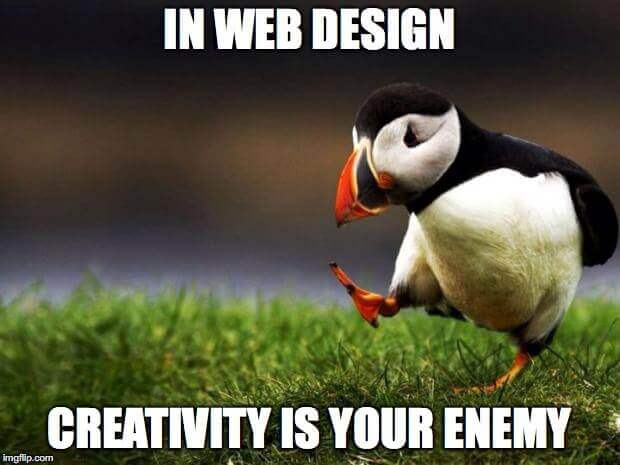
Thats right, I said it.
I don’t know if I have any project where I was told to “make sure it’s really creative” that didn’t turn out disastrously. Somehow good clients know that “what you think is best” is the appropriate directive for how I should approach the design of a new project.
We don’t deal in creativity, we deal in convention.
You know the sites that have decided to take creative liberties with the convention of their site navigation, because you can’t figure out how it’s meant to work. Or the new trend that we currently loathe: hiding the nav behind a hamburger on the desktop size site. I’m sorry, is my 22″ monitor too small to handle your massive site structure? No, you just felt like hiding it? Did the entire human race suddenly change their behavior when encountering a new website?
![]()
Human beings do not read, they scan.
We are pattern detection machines. Whether it’s tracking prey or browsing Pinterest, our brains are hard at work processing the patterns we’re presented with and filtering them through the list of things we recognize to give us a fast, and mostly accurate, response. That’s not up for debate, that is just how it works. So when you hit a page, your eye movement roughly follows the above graphic: first we check out the eyes in the photo, this is one of our social patterns- trying to judge the emotional state and intention of the owner of said eyes, and then moving through the content in an “F” pattern, looking for the familiar word shapes in the text to confirm what we expect to see.
Predictability is bliss.
Lets try a few more examples so we can drive this point home with interfaces that aren’t considered as “creative” or “artistic” (/vomit):
- Car interiors: Imagine if every single car you got into was completely different, because the designer was told to “be creative” so that it would be “unique”. You would have to RELEARN how to drive every time you got into the car! It’s bad enough when I get in a car with the wiper lever on the opposite side of the wheel!
- Bathrooms: You step into a restroom, nay, a creative restroom, and you’ve really got to go. But wait, the designer of the toilet, shower, sink, etc were told to be as creative as possible, since they were told they are the “artsy type”. Yeah you’ve got a problem.
- Traffic Signals: What if sometimes the signals were hidden? What if some stop signs were triangles, or green? How would you know what to look for?
- Stove/Oven: How many burned fingers would it take to learn a new way to use a cooktop?
But but but it’s so boring, it’s not exciting, it’s not different, how can it be recognizable and on-brand while still being conventional?
I sympathize with this sentiment. A lot. Every time I design something in fact. What makes my work different from anyone else’s if we’re following roughly the same conventions?
What makes a Bentley different from a Toyota?
Think about that for a minute. Same structure, same concept, same intended purpose, same interfaces and interactions…vastly different user experience. And yes, very recognizable and consistent with each brand. Now take that and think about your bathroom or kitchen vs your dream bathroom or kitchen. It’s all the same stuff…just…nicer. And in a style you like! For me, that’s the ultra modern, clean lines of IKEA, for someone else it’s the reclaimed wood, concrete, and burnished bronze of Restoration Hardware.
Okay actually I do love both of those things.
Anyway- the point is that the interactions and basic interface elements are nearly identical, the conventions are followed to the letter because that’s what makes them easy to use. The style, the feel of the material and thoughtful placement of conveniences, that’s what makes you love using it.
When you make creativity the enemy of convention, everyone loses.
As I’ve said, they don’t have to be! And yet people still ask for us to break interface conventions, to do things that fly in the face of decades of psychology research, modern usability testing, and audience analysis. Because they want us to be “creative”. And to harken back to my other scandalous post, part of that is because we let it happen. By sequestering ourselves away from the rational, the logic-based domain of programming. And part of it is because we fall victim to ego, to bad advice, to ignorance- whatever it is, it happens, and if you don’t stop it you’re gonna have a bad time.





